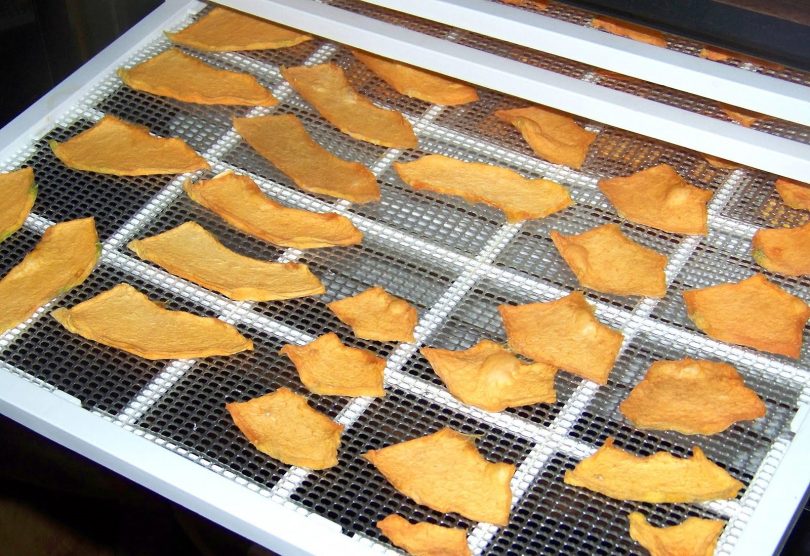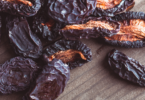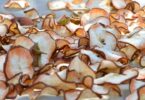Learn how to dehydrate cantaloupe at home!
Cantaloupe is an amazingly healthy fruit, and when you wish to dehydrate it, you have even more possibilities to use it. Dehydrated cantaloupe can be used as a snack or used in trail mix, as well as in numerous recipes, and dehydrating it yourself is easier than you think.
If you’re interested in dehydrating cantaloupe, just follow the easy steps listed below.
How to Dehydrate Cantaloupe
Preparing cantaloupe for dehydration
Wash the cantaloupe. Use a vegetable brush to scrub the outside of the cantaloupe and wash it with warm water only.
Once it’s nice and clean, dry it with a paper towel and you’re ready for the next step.
Peel and slice the cantaloupe. Peel the cantaloupe by removing all of the rinds, cut the fruit in half, then scoop out all of the seeds in the center of each half. Each half will be cut into four slices, then into four more slices, so that you end up with a total of eight slices per half of the cantaloupe. If the cantaloupe is especially large and the slices are too thick, go ahead and slice them again because, in the end, you want all of your slices to be very thin.
Dehydrating cantaloupe in the oven
Next, it’s time to put the slices into the oven. Start by taking a long piece of cheesecloth and putting it directly on the rack in the center of the oven.
Lay each slice of cantaloupe directly on the cheesecloth and make sure none of the slices are touching. In fact, each slice needs to have a space between that slice and the one next to it.
Set your oven at 145° Fahrenheit, but leave the oven door slightly ajar so that steam can escape. The amount of time you leave the cantaloupe in there will vary because it will depend on how you like your cantaloupe to taste when you’re done. Some like it crispy, while others like it less firm and a little on the chewy side. As a general rule, however, you should allow up to 8 hours for the cantaloupe to dry completely.
Dehydrating cantaloupe with a food dehydrator
Each food dehydrator is different, but you can start by setting the temperature at 135° Fahrenheit and leaving the fruit slices in there for 16 to 18 hours. Of course, you’ll need to check with your user’s manual because if their instructions are different from these, you should go with the instructions in the manual instead.
Once again, the slices need to have spaces between them so that none of them touch.
SEE ALSO: A Guide for Beginners: How to Dehydrate Food with a Dehydrator
Air-drying cantaloupe
If you live in an area that gets to about 100° Fahrenheit and which doesn’t get too humid, you can place the cantaloupe slices on a tray and keep the tray outside for two to four days. If you do this, bring the trays inside at night to protect them from the dew, turn the slices over daily so they’ll be even, and start by placing the slices on a baking tray covered with cheesecloth. If there are a lot of bugs in the area, cover the tray with cheesecloth to keep them away from the fruit. Otherwise, after two to four days, the fruit should be dehydrated enough to taste yummy.
If you use this last method, you might want to check the forecast to make sure the next two to four days are going to be hot enough to work because if you don’t have that much time, it could ruin the project for you. You need two to four days of consistent hot temperatures and no rain because you’ll be placing these trays directly in the sun outside, and if you don’t have enough time to finish, it can ruin the cantaloupe pieces.
In any case, you have several options when it comes to drying your cantaloupe slices, and it makes for a very versatile and tasty treat in the end.
How to Store Your Cantaloupe Slices
The main thing you need to remember when storing your cantaloupe slices is to keep them in an airtight container away from direct sunlight. The container should be something like a resealable plastic bag or a plastic container with an airtight lid. If you place the container in a paper bag, this will keep away the direct sunlight, which you want to avoid because it can discolor the fruit pieces.
Finally, keeping the bag in a cabinet is best because the fruit will stay cool and dry and therefore much juicier. Too much heat and humidity means they won’t last as long, but if you store dehydrated cantaloupe slices correctly and keep them in an airtight container and in a cool, dark place, you can keep them for up to one year and enjoy them that entire time.
SEE ALSO: Step-By-Step: How to Store Dried Fruits at Home
Dehydrated cantaloupe is a great-tasting snack, and it’s good to know you can dry them yourself without spending either a lot of time or a lot of money.





